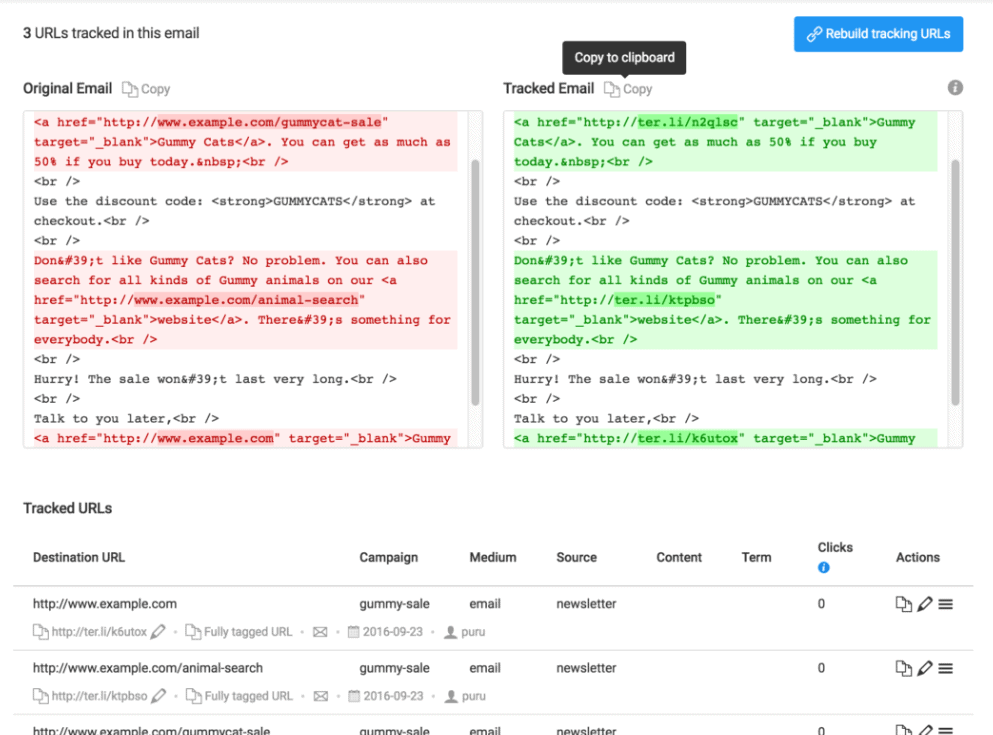Just about everybody uses email, and if we’re talking numbers, “just about everybody” equates to roughly 3.9 billion users worldwide. That number is steadily on the rise, so if you have yet to develop an email marketing strategy, now is the best time to start.
Emails are critical components to successful marketing campaigns not only because they’re such ubiquitous and effective communication tools, but also because they’re action-oriented and measurable. Emails are transactional by nature and contain calls to action tailored to specific audiences. Most importantly, they’re measurable, allowing the sender to obtain key marketing metrics through link click tracking.
Link tracking takes the guesswork out of where your emails succeed and where they’re falling flat. And like learning any new skill, finding out how to best track email links is a process that takes some trial and error. To make it easy for you, here’s a step-by-step guide on how to track links in emails.
How to Track Links in Emails
1. Start by identifying your target audience.
Understand who your customers are, and you’ll be better able to target them with relevant messaging. Intimately knowing where your audience members live, how old they are, what language they speak, their spending power, and their interests will lay the fundamental groundwork for a successful campaign.
2. Build out your email campaign.
Once you have your target audience established, it’s time to draft and build out your campaign. Before getting into the nitty-gritty of writing compelling subject lines and killer body content, identify the goal of your campaign. Ask yourself what the need for your emails are, and why your audience will benefit from them. From there, begin drafting copy, finding imagery, and scheduling out your campaign. And be to leave wiggle room in your schedule for test rounds before sending emails right off the bat!
3. Set up an email journey.
Email journeys are automated emails that are sent based on triggers you define, allowing you to send out the right content at the right time. Those triggers could be a certain date or actions, such as a customer abandoning their cart or the way a subscriber interacts with your emails. Not only do automated emails save marketers time in the long run, but when they’re personalized, they actually yield higher click-through and conversion rates. Most email marketing services, like MailChimp, AWeber, and Constant Contact offer automation features that can help you set up your email journey.
4. Create UTM codes for all email links.
Now, it’s time to create UTM codes for all the links in the body of your emails. This is usually the part that makes email marketers groan, but UTM building doesn’t need to be painful. Using Terminus’ email tracking feature, you can quickly choose which of the URLs in the email you want to track. From there, it’s easy to specify custom UTM parameters while enforcing consistent conventions for accuracy in reporting.
When creating UTM parameters, you’re essentially establishing link tracking tags that identify things like the URL’s source, medium and campaign name. You can also track individual links by keywords, which are automatically generated to identify each link.
Once your tracking tags are applied to the links in your new emails, you’ll need to refresh any draft campaigns or active journey emails to track to those as well.
5. Find your results in Google Analytics.
You can find your tracked email reports in the “Reporting” tab of your Google Analytics account. In the sidebar, click Acquisition > Campaigns > All Campaigns. Here, you’ll be able to track sales, conversions, and A/B campaigns. You’ll also find insights into user behavior, such as bounce rates and average session durations.
Before you begin tracking links in your email campaigns, check out these frequently asked questions for more guidance:
Email Tracking FAQs
What does UTM mean?
A UTM (urchin tracking module) is a simple code attached to a custom URL in order to track its source, medium, and campaign name. UTMs acquire the data you need to understand the effectiveness of your campaigns.
How do I measure clicked links?
You can sort through your results by the specific tags you added to your URLs using Google Analytics or an analytics tool of your choice.
How do I turn click tracking on or off?
Most email marketing services have toggle switches that turn link tracking on or off. Using the Terminus app, you have the option to send a tracked email with the click of a button in your email builder.
How do I track email clicks using Bitly links?
Links created with Bitly are easily tracked. After logging into your Bitly account, head to your dashboard, which shows you a comprehensive view of sharing and engagement metrics. Here’s a deeper dive on how to track email clicks using Bitly.
Is it possible to track clicks on Bitly links AND uniquely identify users’ actions post-click?
Definitely. You’ll just need to add your specific UTM parameters to the link before shortening it with Bitly. For example, if you want to tweet a URL and then track how many users signed on to your website as a result of that, you can add the following parameters:
utm_campaign=<campaign name>
utm_medium=social
utm_source=twitter
utm_content=<some unique link ID>
Then, shorten the link with Bitly before tweeting. The data will come back to you in the form of a _utmz cookie, which contains information about how and when an individual visits your site for the first time.
How does click tracking look in plain text campaigns?
Plain text campaigns don’t use hyperlinks to conceal entire URLs, so your audience will see the full link. Consider creating shortened, custom URLs for good-looking links in plain-text campaigns.
Can I see who has clicked a link in my email?
Certain email marketing providers allow insights into who has clicked a link in your email, including MailChimp and Constant Contact. Bonus: the Terminus app is also compatible with these platforms.
Conclusion
Tracking email click links is a surefire way to better understand your email marketing campaign’s effectiveness. Given the abundance of resources online, you’ll be able to get going with tracking links in emails in no time, and with help from the Terminus app, you can easily add consistent UTM parameters to all your email links. If you haven’t already, start your zero-risk, 21-day free trial today.

